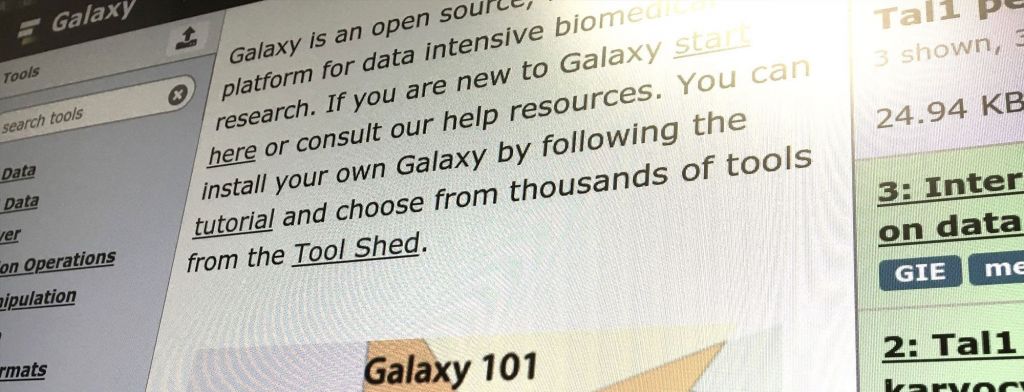
The Roar supercomputer is Penn State's high-performance research cloud, managed by the Institution for Computational and Data Sciences. There are free and paid allocations available to Penn State researchers, including participants in the BG program. More information and instructions for access are available on the ICDS website.
A further list of bioinformatics tools, platforms, and software developed by Penn State researchers for biological data analysis is available below.
Galaxy, an open, web-based platform for accessible, reproducible and transparent computational biomedical research
Biostars-Bioinformatics Explained, a forum to explore bioinformatics, computational genomics and biological data analyses
Biostars-Galaxy Explained, a forum to explore Galaxy
Neurostars, a forum to engage Neuroinformatics community
PyBlue, a simple static site generator
Genetrack, a bioinformatics software package for sorting, queirying and visualizing interval oriented data
BooleanNet, a Boolean network simulation software for life science
Genome browser with erythroid transcription factor occupancy and other features of gene regulation, genome-wide in mouse
KmerGenie, kmer size selection for genome assembly
TwoPaCo, deBruijn graph construction from complete genomes
bcalm, deBruijn graph compaction in low memory
FlowgramFixer, base caller for IonTorrent sequencing data
SPRITE, parallel SNP Detection Pipeline
FASCIA, parallel subgraph counting for determining approximate counts of tree-structured subgraphs in large networks
BEAM (Source code), BEAM2 (Source code), BEAM3 (Souce code, compiling needs GNU Scientific Library) and BEAMimpute for SNP-SNP interaction association mapping
PASS, PASS2 (Source code) Peak calling in ChIP data based on Poisson de-clumping, controls FWER and FDR
GPASS for detecting SNP disease associations in case control studies
dCaP Joint peak caller and differential binding detector for ChIP-Seq data in multiple samples.
DBM Dynamic Bayesian Markov model for genotype calling, haplotype inference, de novo inference of population structure and local admixture for next-gen sequencing data
TIPS Tree based Bayesian detection method of subtle population structures
CHB Coalescence guided Baysian inference of haplotypes from genotype data
EulerAlign Alignment of DNA sequences using Eulerian graphs
MultiGPS, a framework for analyzing collections of multi-condition ChiP-seq datasets
STAMP, a webserver resource for aligning transcription factor DNA binding motifs
PipMaker and MultiPipMaker server software (bzipped tar file of source code; beta version; latest release: 2011-Aug-12)
LASTZ alignment program (latest release: 1.02.00, 2010-Jan-12)
VennGenerator (latest release: 2009-Jul-23)
DIAL (gzipped tar file of source code; latest release: 2011-Jun-06)
YASRA, Yet Another Short Read Assembler (gzipped tar file of source code; latest release: 2014-Mar-27)
CHAP (fast version; gzipped tar file; 71 Mb; 2011-Aug-02)
CHAP 2 (link to GitHub)
StructureFold, at Galaxy, for RNA secondary structure mapping and reconstruction
ShortStack, for comprehensive annotation and quantification of small RNA genes
PrISE : Prediction of protein-protein Interface residues using Structural Elements
EnsembleGly: glycosylation site prediction
PRIDB: The Protein-RNA Interaction Database
ProtinDB - PROTein-protein INterface residues Data Base
INDUS - INtelligent Data Understanding System
Flynotyper, a quantitative tool for functional genetic analysis in D. melanogaster
Phenogram, for creating chromosomal ideograms
PheWAS-View, for visually integrating PheWAS results
PLATO, a Platform for the Analysis, Translation and Organization of large-scale data
Synthesis-View, for data visualization
Spectrum/EPP: Estimation and Projection Package is used to estimate and project adult HIV prevalence and incidence from surveillance data.
IMIS: R-package for Incremental Mixture Importance Sampling. Reference: Raftery and Bao (2010) Biometrics.
LiBaC: The primary use is to identify positively selected sites when the process of evolution is highly heterogeneous among sites. Reference: Bao, Gu, Dunn and Bielawski (2008) Molecular Biology and Evolution.
Precursor Identifier, Identify biomass precursors that are not produced upon essential (synthetic lethal) gene deletion
OptCom, a comprehensive modeling framework for the flux balance analysis of microbial communities
OptForce, identify the minimal set of genetic interventions that shape the metabolism of a microorganism
SL Finder identify synthetic lethal genes or reactions in genome-scale metabolic models
EMU generato, Elementary Metabolite Unit generation code for isotope mapping models
GrowMatch, reconciling in silico predictions with in vivo growth observations
GapFind/GapFill, identifying and filling network gaps for genome-scale metabolic models
OptKnock, strain redesign for overproduction using gene/reaction deletions
IPRO, integrated environment for various protein engineering tasks
MAPs, a database of Modular Antibody Parts for predicting and designing antibody variable domains
OptZyme, enzyme redesign through the use of transition state analogues
OptCDR, de novo design of antibody Complementarity Determining Regions for binding targeted epitopes in antigens
eShuffle, prediction of crossover distributions using DNA shuffling